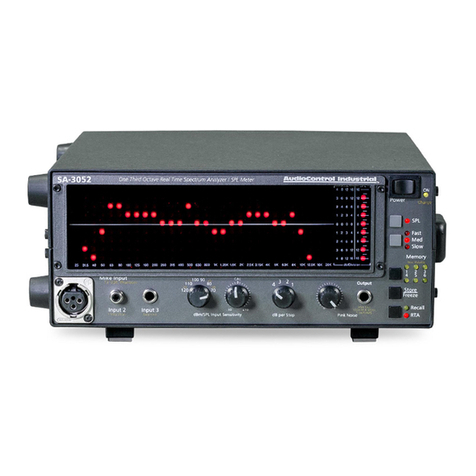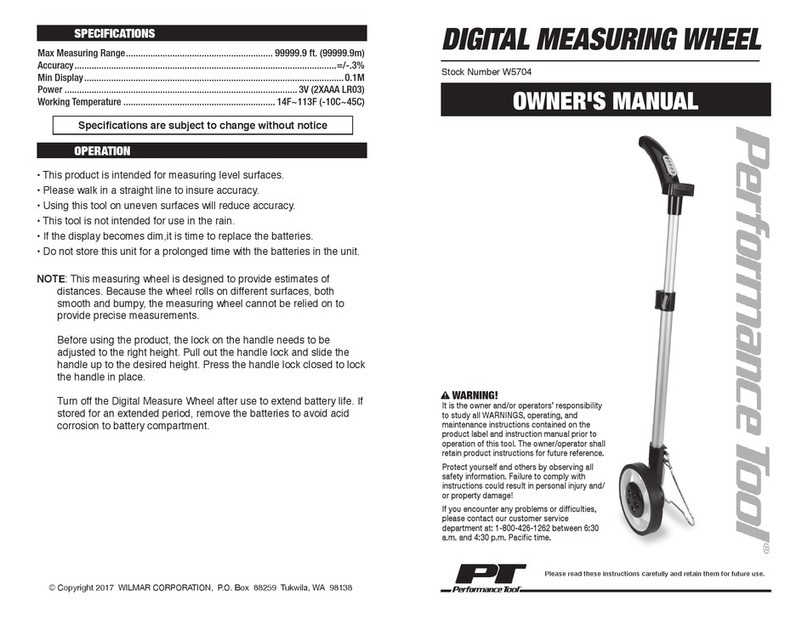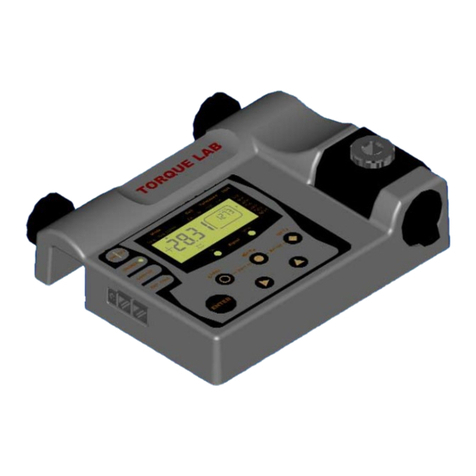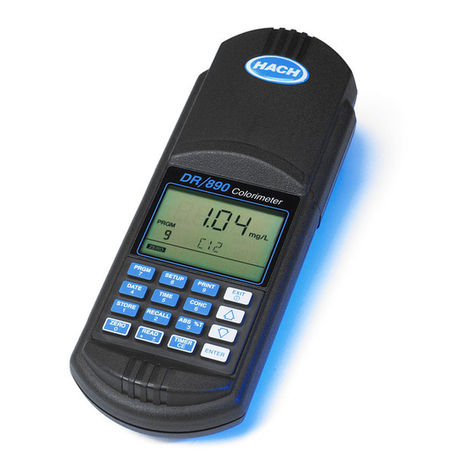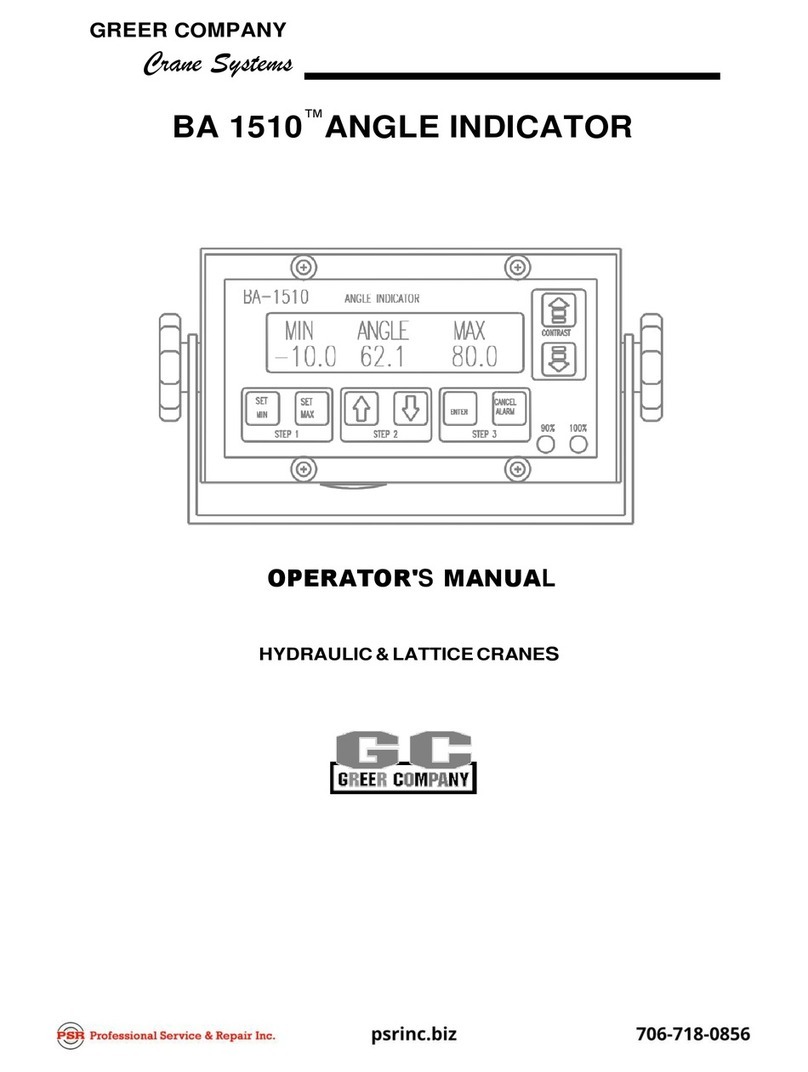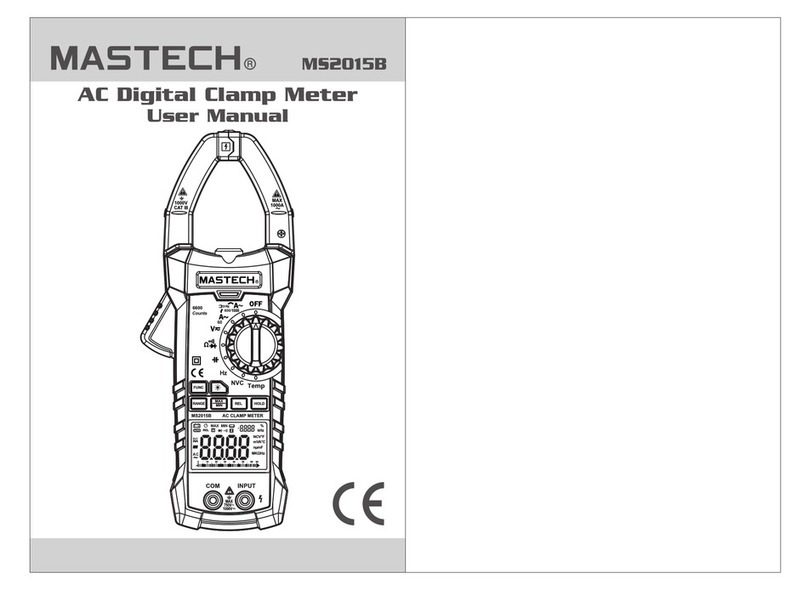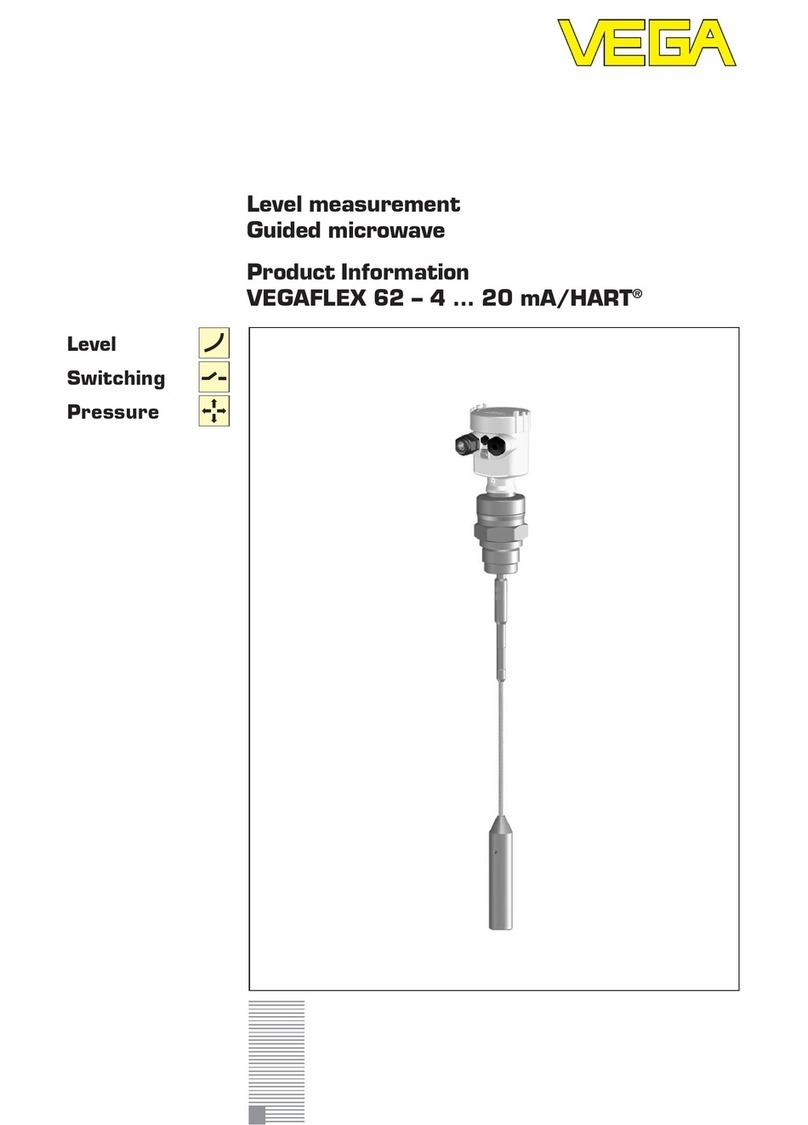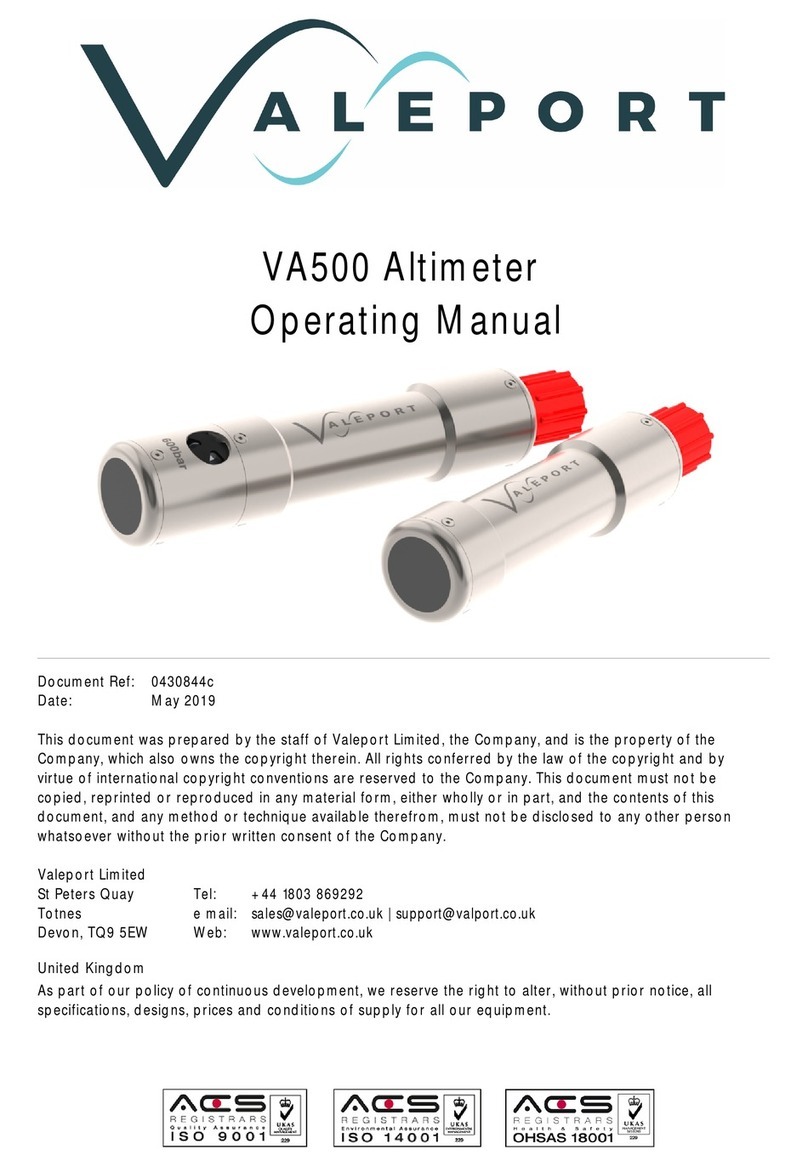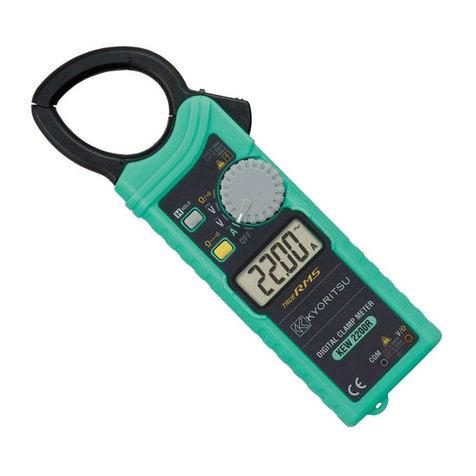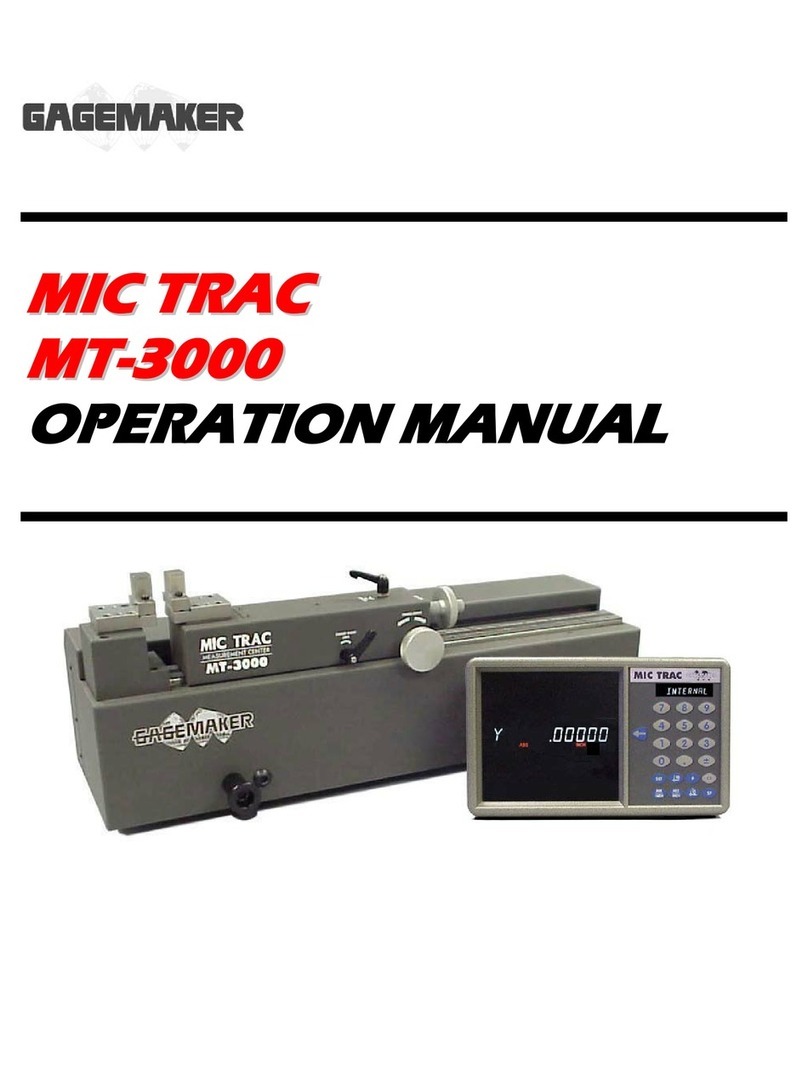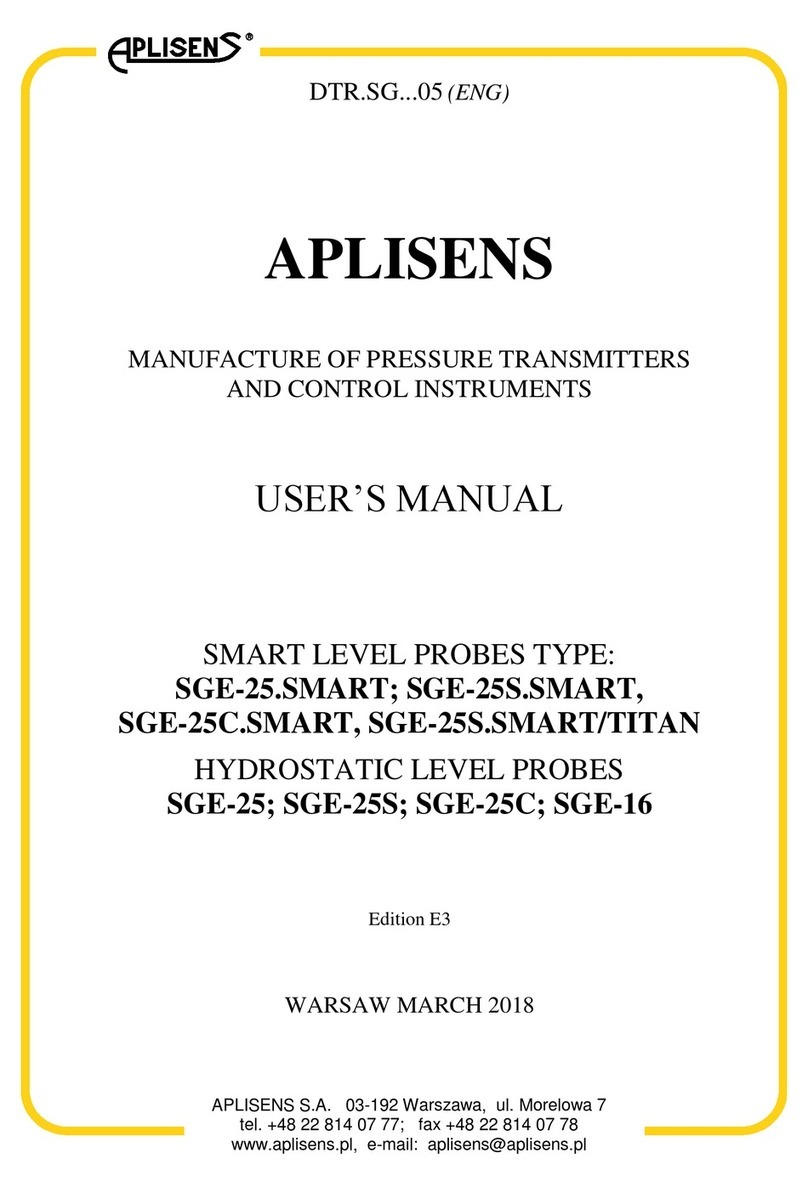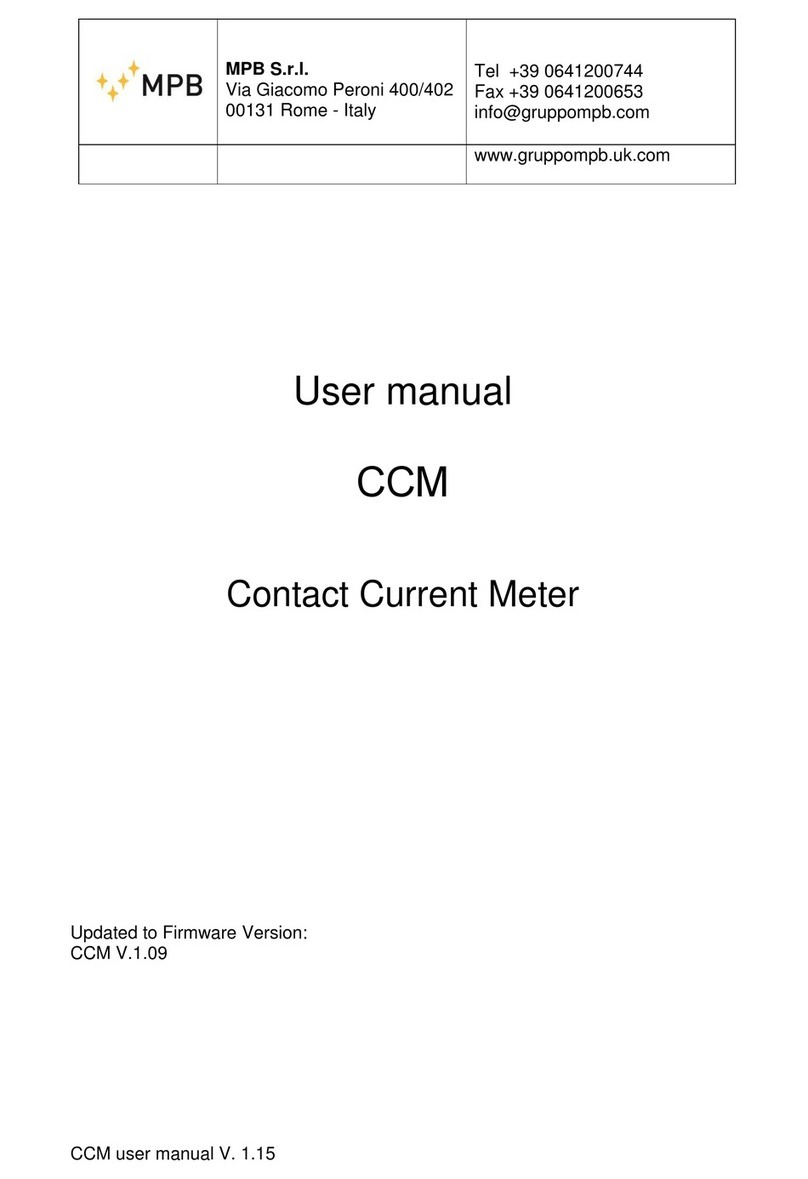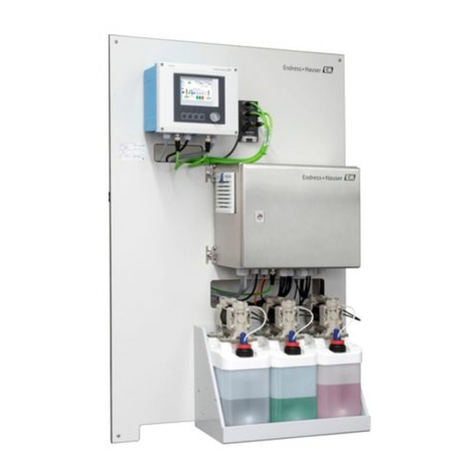Audio Control SA-3052A User manual

tmSA-3052Atm
Competition Autosound
Analyzer/SPL Meter
22410 70th Avenue West • Mountlake Terrace, WA 98043
Phone 425-775-8461 • Fax 425-778-3166 • Internet http://www.audiocontrol.com
© 2014 AudioControl. All rights reserved.
Operation Manual
®
P/N 9021100
SA-3052

SA-3052A Owner’s Manual ®

SA-3052A Owner’s Manual
®
About This Manual ......................................................i
Notational Conventions ...............................................i
Notes, Cautions, and Warnings ....................................ii
Chapter 1 Introduction
Test Instruments vs. Toys.............................................1-1
ANSI Filter Design ......................................................1-2
Applications .................................................................1-3
Accessory Information.................................................1-3
Chapter 2 SA-3052A Front and Rear Panel Features
Front Panel...................................................................2-1
Rear Panel ....................................................................2-4
Chapter 3 Operation
Quick-Start Information...............................................3-1
Using The SA-3052A’s Functions ...............................3-1
Storing and Recalling a Response Curve.....................3-1
Averaging Several Readings ........................................3-2
Peak-Hold; RTA and Digital SPL ................................3-2
Clearing the Internal Memories ...................................3-2
Printer Operation..........................................................3-2
Printers Supported........................................................3-2
Connector Pin Designations.........................................3-3
Battery Operation.........................................................3-4
A and C Weighted Measurements................................3-5
Getting extreme at 175dB SPL ....................................3-6
Chapter 4 Acoustical Testing with the SA-3052A
Overview......................................................................4-1
Basic Procedure ...........................................................4-2
Body Effects.................................................................4-3
Sound Pressure Level and Hearing Loss .....................4-3
Chapter 5 A Primer on Car Acoustics .........................................5-1
Chapter 6 Getting the Last ¼ dB
Getting the Last 1/4db .................................................. 6-1
Setting Gain Levels.................................................... 6-12
Chapter 7 Contest Scoring
IASCA Scoring ............................................................7-1
USAC Scoring .............................................................7-1
Chapter 8 Other SA-3052A Applications
Sound System Equalization .........................................8-1
Hi-Fi Equalization........................................................8-1
Component Checkout...................................................8-4
Sound and Music Monitoring ......................................8-6
Crossover Testing.........................................................8-7
Chapter 9 Theory of Operation
Input Circuitry .............................................................9-1
One-Third Octave Filters .............................................9-1
Signal Multiplexing & Analog to Digital Conversion .9-1
Microprocessor Circuitry.............................................9-2
LED Display ................................................................9-2
Pink Noise Generator...................................................9-2
Chapter 10 Warranty
Legalese .................................................................... 10-1
Service Information ................................................... 10-1
Chapter 11 Specications............................................................. 11-1
Table of Contents
© 2014 AudioControl. All rights reserved.

SA-3052A Owner’s Manual ®

SA-3052A Owner’s Manual
®
About This Manual
This manual describes the AudioControl SA-3052A and a few of its audio applica-
tions. The manual is divided into several major sections.
Chapter 1. Introduction is an overview of the SA-3052A and to this manual.
Chapter 2. SA-3052A Front and Rear Panel Features describes the physical features
found on the front and rear panels of the SA-3052A.
Chapter 3. Operation describes how to use the various functions of the SA-3052A
Chapter 4. Acoustical Testing with the SA-3052A has procedures for using the
SA-3052A for sound system equalization and analysis.
Chapter 5. Car Acoustics looks at the research and specics of automobile
acoustics.
Chapter 6. Last ¼ dB describes some advanced topics.
Chapter 7. Contest Scoring explains the special programming built into the SA-
3052A for car stereo contests.
Chapter 8. SA-3052A Applications describes a few other applications for the
SA-3052A besides equalizing sound systems.
Chapter 9. Theory of Operation, for terminally curious technoids only, is a descrip-
tion of what goes on inside the connes of the box.
Chapter 10. Warranty Information describes the SA-3052A warranty and tells how to
obtain service for the SA-3052A. We trust that you’ll never need to use
this section.
Chapter 11. Specications lists the SA-3052A’s specications.
i

SA-3052A Owner’s Manual ®
Notational Conventions
Within this manual, several different notation conventions are used to indicate various facets
of the SA-3052A’s features.
Small CapS Indicate a marked feature on the unit, like a control or a connector.
They are also used within procedures to identify controls and switches
by function.
Italics and boldface Are used for emphasis. Words printed in boldface convey more em
phasis than those printed in italics.
Notes, Cautions, and Warnings
Some of the text in this manual is set apart by the headings: Note, Caution, or Warning
These terms are used to denote varying degrees of awareness required by the user during
installation, operation, or maintenance of the SA-3052A.
ii
NOTE conveys information that may be helpful to the user. A note is
similar to an aside during a conversation.
CAUTION indicates a potential danger to the instrument.
WARNING indicates a potential hazard to the operator.

SA-3052A Owner’s Manual
1-1
®
Chapter 1 - Introduction
Introduction
Congratulations on purchasing one of the world’s most popular audio analyzers. The
AudioControl SA-3052A is an affordable, measurement-grade, one-third octave real-time
analyzer designed for audio signal analysis. Previous analyzer designs were either too costly
for the average professional or too inaccurate for serious use. The SA-3052A overcomes
these inadequacies by combining a state-of-the-art microprocessor-based design with mod-
ern electronic manufacturing techniques. The result is a very accurate, quick and easy to use
instrument, self contained in one box.
The SA-3052A includes the following features:
• Car stereo contest scoring
• Portable battery operation
• Parallel printer port
• Completely self contained opeating system and programing
• 30 one-third octave bandwidth filters
• Fourth-order filters conform to ANSI S1.11-1986 standards
• Laboratory-grade calibrated measurement microphone
• Internal digital pink noise source
• 36 dB display window
• 9 x 30 large-format LED display matrix
• Full-screen digital SPL readout with 1/10th dB resolution
• Six non-volatile memories with lithium battery backup
• Frequency response averaging for up to six stored response curves
• 20 second temporal averaging
• Peak-hold
• Balanced XLR microphone, balanced TRS ¼” phone jack and unbalanced RCA
connector inputs
• 175 dB sound pressure level measurement (optional)
Test Instruments vs. Toys
There is a fundamental difference between the many real-time analyzers currently
available on the market today. That difference is one of calibration. An instrument that is
calibrated is capable of making measurements based on some absolute reference (absolute
measurement).
An instrument that isn’t calibrated can only make comparisons against a relative refer-
ence (relative measurement). For example, someone asks you, “How hot is it today?” If you
step outside for a moment and reply, “Oh, a bit hotter than yesterday,” that’s a relative mea-
surement. On the other hand, if you step outside and consult a certied laboratory thermom-
eter and say “85 degrees F,” you’ve made a measurement against an absolute reference.
The SA-3052A was calibrated at the factory to meet or exceed its published specica-
tions. You can make a measurement with the SA-3052A and compare it with a measurement
made by any other measurement-grade instrument and know that you are comparing apples
with apples.

SA-3052A Owner’s Manual
1-2
®
Chapter 1 - Introduction
ANSI Filter Design
A real-time analyzer works by dividing the audio spectrum up into equal bandwidth
parts using a set of calibrated (usually) bandpass lters. Then the output of each lter is
displayed on some sort of level indicator: LED matrix, Video display, LCD, etc.
The American National Standards Institute (ANSI) oversees the establishment and
maintenance of various engineering standards in conjunction with the International Stan-
dards Organization (ISO) in Europe. These two standards organizations have established
standards for the performance of the bandpass lters used for acoustical measurement
purposes.
For one-third octave analyzers, there are two classes of lters allowed by ANSI.
These are Class II, and Class III. Class I is reserved for octave bandwidth analyzers.
Class III lters are the hardest to design and manufacture and are usually only found on
the most expensive (read unaffordable) analyzers. Class II lters, are easier (not easy, just
easier) to design and manufacture than Class III lters. Any real-time analyzer intended
for serious measurement work will use lters that at least meet Class II standards.
The lters used in the SA-3052A analyzer meet or exceed the standards specied by
ANSI for a Class II, Type E lter set. Simply, they are very, very good but still affordable.
Figures 1.1 and 1.2 show two different one-third octave lters. Figure 1.1 is repre-
sentative of those found in most analyzers. Figure 1.2 is an actual lter used in the
SA-3052A. Note the difference in the response away from the center frequency. The
inferior lter’s broad response characteristic translates to potential measurement errors at
frequencies removed from the band-center and undesirable interaction between adjacent
frequency bands.
Figure 1.1. A non-measurement quality one-third octave filter
Figure 1.2. A measurement quality one-third octave filter

SA-3052A Owner’s Manual
1-3
®
Applications
The SA-3052A is well-suited to many audio applications including but not limited
to:
• Acoustical analysis for sound reinforcement or recording studios
• Equalizer adjustment and setup
• Crossover level setting and verification of frequency
• Gain matching and setting at various stages of the signal chain
• Movie theater system setup and alignment
• Industrial noise measurement
Special Features
Rechargeable Internal Battery Pack
The rechargeable battery option allows the SA-3052A to be used independent of
AC mains power. The batteries install within the instrument and provide up to 4
hours of operation on a full charge.
The batteries are recharged by plugging the instrument into a source of AC mains
power and leaving the front panel power switch set to off for a period of 9 to 10
hours. When charging, the power light glows red. When fully charged the red
power light flashes occasionally.
Printer Output
The printer output option provides a Centronics parallel interface for a PC
compatible printer (not provided). The analyzer-to-printer cable is a standard
PC-type parallel printer cable (also not provided).
The printed output is a form with suitable blank spaces for recording the time and
place of the measurement and other data, followed by the a printed representation
of the real-time spectrum display on the analyzer.
On-screen score display
For quick check-ups in the shop when you don’t have a printer handy, the SA-
3052A will display the frequency response score on the screen. Of course if you
do have a printer, the SA-3052A provides complete information about the individ-
ual response deviations on a special printout.
Automatic SPL judging
Forget about finding your stopwatch. Forget about disputes over SPL scores. The
SA-3052A automatically times 30 seconds and holds the loudest SPL peak during
the count-down. An LED bar ticks off the seconds for great crowd appeal.
No computer required
The SA-3052A works directly with your PC-compatible printer. Just plug your
printer into the SA-3052A and you’re ready to go.
SC-10 Soft Carrying Case
The optional soft carrying case protects the SA-3052A from the ravages of porta
ble operation. It includes a large pocket to carry the mike and cables. There is also
a hatch on the bottom of the case to allow access to the power cord connection.
Chapter 1 - Introduction

SA-3052A Owner’s Manual
1-4
®
Options
Customized Printout
The CP-10 option customizes the printer output form to include six lines of data
for your business name, address, and other data. Since this data is only factory
installed, it has the additional benefit of “branding” your analyzer in case someone
wanders off with your prize analyzer.
AC-10 A- and C-weighting Filter
The AC-10 A/C weighting filter is a compact plug-in module designed to be
inserted inline with the microphone. The AC-10 applies the standard A- or C-
weighting function to the microphone signal.
Very High SPL option
The high SPL option allows sound pressure level measurements over 170 dB. This
option includes a high SPL microphone and software upgrades.
External SPL Display
Designed for SPL contests, this option includes a large, very bright SPL display
which connects to the SA-3052A. The output is in big, bold numbers, which are
easily readable by the contest crowd. Two analyzers and displays may be started
simultaneously by a single simulstart button (SS-10).
Chapter 1 - Introduction

SA-3052A Owner’s Manual
2-1
®
Front Panel
LED DispLay
The left portion of the display shows the one-third octave energy content of the input
signal from 25 Hz to 20kHz. Each column within the display represents a single one-third
octave band. The band centers are marked on the bottom of the screen.
The right-hand end of the display indicates the setting of the DBswitch, and conse-
quently the amount of change in the input signal that each LED on the left- hand side of
the display represents.
The far right portion of the display indicates the sound pressure level (SPL), relative
to the settings of the DBswitch and control.
powEr switch
Depressing the powEr switch to the right turns the SA-3052A on. Pressing it to the left
turns it off.
Low Batt/powEr/chargE LED
The Low Batt/powEr indicator illuminates solid green during normal operation of the
SA-3052A. When operating the SA-3052A on the optional internal rechargeable batter-
ies, a ashing green LED indicates that the batteries need recharging. Once the Low Batt
LED has begun ashing, there is approximately ½ hour of battery life remaining.
The SA-3052A has a sense circuit that prevents operation of the instrument below
critical battery cell voltage. This prevents total battery discharge, which shortens the cell
life.
To continue operation, the SA-3052A may be operated from the AC power line. The
batteries may be recharged by plugging the SA-3052A into a suitable source of AC pow-
er, with the front panel powEr switch set to the off position for a period of 9 to 10 hours.
The power LED will glow red while the batteries are charging. The minimum recharge
time from the voltage-cutout state is around 2 hours, which will then operate the instru-
ment for around one hour. Completely recharging the batteries from a discharged state
(instrument dead) requires 9 to 10 hours (2 times the discharge time).
Figure 2.1. SA-3052A Front Panel
Chapter 2 - SA-3052A Front and Rear Panel Features
SA-3052

SA-3052A Owner’s Manual
2-2
®
Chapter 2 - SA-3055 Front and Rear Panel Features
SPL
Momentarily pressing the spL push-button switch toggles the SPL bargraph at the
right side of the display window on and off. Pressing and holding the SPL push-button
activates the full-screen digital SPL display. Momentarily pressing the SPL switch again
restores normal analyzer operation. The associated LED indicator indicates the status of the
SPL switch. The SPL bargraph display scaling is always 4 dB/step, regardless of the set-
ting of the dB switch. The SPL switch works regardless of the setting of the rEcaLL/rta
switch. This means that you can switch the SPL bargraph on and off even with a stored
display.
DispLay spEED
The display speed push-button switch is located underneath the SPL switch and to the
left of the fast, MED and sLow LEDs.
The lighted LEDs to the right of the switch indicate the response time of the display.
Press the button to change the decay time of the display. The Fast setting is optimized for
looking at transients in conjunction with peak hold, the Med setting is useful for program
monitoring, and the Slow setting averages 20 samples over a ½ second period. This works
well for measurements using pink noise. A fourth display speed is a 20 second time aver-
age. It is indicated by the sLow LED ashing. During the rst 20 seconds as the average
is accumulating, the Slow LED will ash 2 times per second. Once the accumulator is full,
the ashing will slow down to 1 ash per second.
MEMory
The SA-3052A can store up to six different frequency response curves (including
the SPL bar graph display) in its internal non-volatile memory. These memories are stored
at the highest resolution of the SA-3052A, so you can scale the display with the DB/stEp
switch during memory recall. Any combination of the memories can also be averaged.
Look in the Operation section of this manual for further information.
An internal back-up battery maintains the contents of the memory for periods of up
to one year, even with the AC power supply disconnected. This feature allows the unit to
“remember” a standard curve that may be recalled each time that the SA-3052A is used.
pink noisE
The internal pink-noise generator is an accurate, digital, laboratory-grade test source.
The pink noise output is accurate throughout the measurement range to within 0.25dB.
The maximum output provided at the ¼” tip-sleeve phone jack is 1 volt into a 600
load (unbalanced, ring and sleeve grounded), or 150 mW into a 4 ohm load.
The signal level at this connector is controlled by the knob to its immediate left.
The pink noise generator has sufcient output to drive virtually any speaker or cross-
over directly.
DB pEr stEp
This switch sets the resolution of the spectrum analyzer portion of the display. The setting
represents the value of each LED in the display. Thus, a setting of 1dB per step causes
each LED in the display to represent a 1dB change. At this setting, the overall range of the
display is 9dB. At the 4-dB-per-step setting, each LED in the display represents a change of
4dB, with a 36dB overall display range.
When using the SA-3052A for sound system equalization, start with the 4 dB/step

SA-3052A Owner’s Manual
2-3
®
setting and progressively decrease the setting of the DB pEr stEp switch as the equalization
process progresses. For program monitoring, the 4dB position works well because it dis-
plays the widest dynamic range.
Memorized response curves are always stored at 1-dB-per-step-resolution, regardless
of the setting of the front panel switch. You can select whatever resolution you wish for a
stored display when it is displayed and know that it is accurate. The same holds true for dis-
plays dumped to the printer output.
DB input sEnsitivity
The DB input sEnsitivity control and switch select the reference level of the curve
shown in the display window. The control to the right of the input selector switch is a ne
adjustment and alters the range selected by the switch over a range of ±10 dB. The normal
setting for this control is the detented (click-stopped) center position.
The reference level of the display is shown on the display window by the light gray
horizontal line. The actual reference level of the reference line corresponds to the dB level
setting of the DB/spL switch.
For example, the DB/spL switch (coarse adjustment) is set to 90dB. The light gray
line on the display window represents a sound pressure level of 90dB if the 10dB control
(ne adjustment) is set at the center-detented position.
input 3
A ¼” tip-ring-sleeve phone jack is used for connecting to balanced and unbalanced
sources. Connect unbalanced sources by using a tip-sleeve (2 conductor) plug inserted into
this jack.
This input has an impedance of 10 kohms and is suitable for signal levels from -
56dBu to +36dBu. An input signal of 0dBu represents 100dB SPL.
input 2
This is a standard audio (RCA) connector with an input impedance of 1 Mohm in
parallel with 30 pF. The particular combination of resistance and capacitance allows con-
necting almost any audio source to this input.
This input is suitable for signal levels from -56dBu to +36dBu. An input signal of
0dBu represents 100dBSPL.
input 1
This is a standard +12 volt, phantom-powered, balanced microphone input. The
phantom power supply is intended for the AudioControl CM-10 or High SPL measurement
microphones.
Ordinary dynamic microphones may also be connected directly to this input provid-
ing that they have a balanced output. Unbalanced microphones may not be used. This input
is suitable for acoustical levels at the microphone ranging from 44dB SPL to 136dB SPL.
The SPL display is only accurate if the AudioControl CM-10 microphone is used, or if the
external microphone matches the sensitivity of the CM-10 microphone.
CAUTION: A microphone with an unbalanced output may be damaged if con-
nected to this input. AudioControl assumes no responsibility for microphones
damaged in this manner. Connect microphones with ¼” phone plug connectors
to the Balanced Input 3 connector.
Chapter 2 - SA-3055 Front and Rear Panel Features

SA-3052A Owner’s Manual
2-4
®
Figure 2.2. SA-3052A Rear Panel
Chapter 2 - SA-3055 Front and Rear Panel Features
Rear Panel
AC Mains power input receptacle
An IEC 3-prong receptacle provides the connection for AC power input to the
SA-3052A.
The SA-3052A is factory supplied to operate at one of the following AC power sup-
ply voltages. The supplied conguration is marked on the rear panel of the unit. Consult
the AudioControl factory for power supply conversion information.
n120 VAC, 60 Hz
n220-240 VAC, 50/60 Hz
Power Fuse
The correct fuse is listed next to the power input receptacle.
Printer Interface (printing function no longer supported)
This is a female 25-pin connector (DB-25F) used for connection to an external
PC-type printer (not supplied). The connector is wired for a parallel interface printer. A
description of the pin connections can be found on page 3-5.
Print (printing function no longer supported)
This momentary-contact switch is used to print the contents of the display onto an
external printer.

SA-3052A Owner’s Manual
3-1
®
Using the SA-3052A is simple and straightforward. This section describes the basic
procedures for using the SA-3052A.
Quick-Start Information
1. Connect the SA-3052A to a suitable source of AC power. If your instrument is
equipped with the battery option, the batteries must be charged before use. The correct
AC power conguration is marked on the rear panel of the instrument.
2. Connect the input signal source to the appropriate input on the front panel of the
instrument.
3. If you are using the internal pink noise source, connect the pink noisE output of
the analyzer to the amplier or sound system line input. The pink noisE output has suf-
cient power capacity to directly drive a loudspeaker to modest levels.
4. Set the DB input switch so that signal peaks reach the upper third of the display.
Adjust the DB input control as needed. If the variable ±10 dB control is centered, then the
gray line dividing the display represents the SPL setting of the DB switch.
5. Select the display resolution using the DB pEr stEp switch. The switch setting
represents the value of each LED in the display. A scale is printed on the right-hand side
of the display window.
6. Select the decay time of the display by pressing the push-button switch adjacent
to the fast, MED, or sLow LEDs. The Fast setting is suitable for viewing transients. The
Med setting is suited to signal monitoring and the Slow setting works well for pink noise
measurements.
7. You can determine the sound pressure level at the microphone by pressing and
holding the spL push-button for one second until the display changes to the digital mode.
This will display the sound pressure level in 1/10th dB (centibel) resolution. The SPL bar-
graph is always 4dB per step, regardless of the setting of the DB pEr stEp switch.
Using The SA-3052A’s Functions
Storing a Response Curve
1. Press the storE/frEEzE button. The display is now frozen and ready to be stored.
2. Pressing the MEMory button again steps through the six memories in sequence.
The display shows the contents of each memory as it is selected.
3. The rEcaLL and rta LEDs are not illuminated. This indicates that the SA-3052A
is ready to store the display.
4. Pressing the storE/frEEzE button again stores the contents of the display into
the selected memory. The associated LED indicators display which memory is currently
active.
5. The yellow rEcaLL LED illuminates to indicate that you are now in recall mode.
You can recall any other memory for comparison purposes by selecting that memory by
repeatedly pressing the Memory button.
6. Press the rEcaLL/rta button to return to real-time mode.
Chapter 3 - Operation

SA-3052A Owner’s Manual
3-2
®
Recalling a Response Curve
1. Press the rEcaLL/rta button until the rEcaLL LED is illuminated.
2. Press the MEMory push-button to successively view the contents of the six
memories.
3. Pressing the rEcaLL/rta button again returns the SA-3052A to the RTA mode.
Averaging Several Readings
The averaging mode allows up to 256 previously stored readings to be averaged
together. The averaged result is stored in memory number six, replacing its contents.
1. Acquire and store up to six response curves.
2. Press and hold the storE/frEEzE button for one second. The yellow MEMory 6
LED is now ashing, indicating the initiation of the averaging mode.
3. Select the rst memory for averaging using the MEMory button. Touch the
storE/frEEzE button once.
4. Select the next memory for averaging using the MEMory button. Touch the
storE/frEEzE button once. Repeat this step for each additional memory to be averaged.
You can weight a specic memory by selecting it more than once.
5. After selecting the memory locations to be averaged, press and hold the storE/
frEEzE button for one second. The MEMory 6 LED will come on solid and the average
will be displayed on the screen and written into memory location 6.
6. The contents of memory location 6 are lost when the average is calculated. The
result of the averaging operation is overwritten into memory location 6.
Peak-Hold
The Peak-Hold mode allows you to accumulate the highest peak level in all of the
SA-3052A’s thirty display bands. This display may be stored in any memory location,
averaged, etc.
1. Press and hold the rta/rEcaLL button for one second. The red rta LED is now
ashing, indicating the peak-hold mode is active. The display now holds the overall peak
level for each of the thirty bands.
2. Pressing the rta/rEcaLL button again exits the peak-hold mode.
Peak-Hold Digital SPL
The digital SPL display may also be operated in peak-hold mode.
1. Press and hold the spL button until the instrument enters digital SPL mode.
2. Press and hold the rEcaLL/rta button until the spL LED starts ashing.
3. The SA-3052A is now in digital SPL peak-hold mode.
Clearing the Internal Memories
1. Press and hold the storE/frEEzE button while turning on the SA-3052A.
Chapter 3 - Operation

SA-3052A Owner’s Manual
3-3
®
Note
The parallel PC printer interface standard does not require any baud rate, parity or
stop bit settings. You should not have to make any special settings in your parallel printer
to use the SA-3052A.
CAUTION: Do not connect the SA-3052A to a serial interface printer (Apple,
Point of Sale, etc.). It will not print, and damage may be done to the analyzer
and/or printer.
Printer Operation
A standard printer interface allows making hard-copy printouts of the SA-3052A’s
display. The printer output is a form with space provided for logging the time and date of
the job, as well as any other data. A sample is shown in gure 3.1. The SA-3052A prints
special output formats when in IASCA or USAC scoring modes.
Printers Supported
The SA-3052A printer interface is designed to connect to any Centronics-type paral-
lel interface compatible printer (dot matrix, ink jet, laser, etc.). No special printer control
codes or emulations are required.
Printing the display is easy.
1. Connect a parallel printer to the Printer Port on the rear of the SA-3052A.
2. Recall the response curve memory that you wish to print...or...freeze the display.
3. Make sure that the printer is loaded with paper, connected to a power source,
turned on, and on-line.
4. Press the rear-panel print button.
Chapter 3 - Operation

SA-3052A Owner’s Manual
3-4
®
PERFORMANCE MATCH
SYSTEM ANALYSIS
By:
Client _ _ _ _ _ _ _ _ _ _ _ _ _ _ _ _ _ Date _ _ _ _ _ _ _ _
Address _ _ _ _ _ _ _ _ _ _ _ _ _ _ _ _ _ Telephone _ _ _ _ _
City _ _ _ _ _ _ _ _ _ _ _ State _ _ _ _ ZipCode _ _ _ _ _ _
Description of Vehicle _ _ _ _ _ _ _ _ _ _ _ _ _ _ _ _ _ _ _ _
AUDIOCONTROL SA-3055 SPECTRUM ANALYSIS
System Frequency Response--One Third Octave
System Components:
Head Unit _ _ _ _ _ _ _ Speakers: Tweeters _ _ _ _ _ _ _ _
Performance Match Midranges _ _ _ _ _ _ _
Units _ _ _ _ _ _ _ _ _ Bass _ _ _ _ _ _ _ _ _ _
Crossover _ _ _ _ _ _ _ Subwoofer _ _ _ _ _ _ _ _
Amplifiers _ _ _ _ _ _ _ _ _ _ _ _ _ _ _ _ _ _ _ _ _ _ _ _ _
Suggested System Improvements _ _ _ _ _ _ _ _ _ _ _ _ _ _ _ _ _
_ _ _ _ _ _ _ _ _ _ _ _ _ _ _ _ _ _ _ _ _ _ _ _ _ _ _ _ _ _ _
Performance Match Technician _ _ _ _ _ _ _ _ _ _ _ _ _ _ _ _ _
25 50 100 200 400 800 1.6k 3.15k 6.3k 12.5k 20k
+12
+9
+6
+3
0
-3
-6
-9
-12
92
89
86
83
80
77
74
71
68
dB
*
***
***
**
*
*
*
*
**
*
*
*
**
****
**
*
*
**
Bass Midrange Treble
SA-3055 V.5.54 (C) 1977 AudioControl (425) 775-8461
Note
An abbreviated printout showing only the RTA curve may also be printed by double-
clicking (pressing twice quickly) the Print button.
Figure 3.1.
Printout Example.
Chapter 3 - Operation

SA-3052A Owner’s Manual
3-5
®
Connector Pin Designations
The printer interface connector uses a DB25F connector. The connector wiring is the
same as that used by PC-type computers so you can use any standard PC printer cable to
connect the SA-3052A to your printer.
The connector pin designations are shown in Figure 3.2.
Battery Operation
A standard battery package allows the SA-3052A to be operated without connection
to the AC mains supply. The battery supply has sufcient capacity to operate the
SA-3052A continuously for 3 to 4 hours. The battery package uses a sealed gel-cel,
lead-acid battery pack.
An integral battery charger operates when the SA-3052A is plugged into the AC
mains supply. The instrument must be turned off to charge the battery.
Charging the Internal Battery Pack
1. Plug the SA-3052A into a suitable source of AC power.
2. Set the front panel powEr switch to off.
3. Leave the SA-3052A for a period of 8 to 10 hours (twice the discharge time).
4. The battery charger automatically adjusts the rate of charge as the battery reaches
full charge. The powEr/chargE LED will glow red then ash slowly when a full charge
is reached. Once this occurs, the battery charger switches to trickle-charge mode to
maintain the battery at full charge. Operating the SA-3052A on AC power will eventually
discharge the battery.
Getting the Most From Your Battery Pack.
The SA-3052A uses a sealed, lead-acid storage battery. These batteries are not of
the Nickel-Cadmium type commonly used for rechargeable applications. Lead-acid bat-
teries offer some signicant advantages over NiCad batteries.
Chapter 3 - Operation
Figure 3.2. Parallel Interface Signals and Pin Assignments.

SA-3052A Owner’s Manual
3-6
®
• Given proper charging and discharge depth, the batteries should deliver 1000 to
2000 charge/discharge cycles (4-5 years of normal operation).
• Lead-Acid cells do not have memory effects from partial discharging or charging.
• Higher energy density. The lead-acid design delivers more energy per unit
volume than NiCad battery systems.
• Lead-acid batteries can be charged in less time than NiCads.
• Wider temperature range: -65 degrees Celsius to +65 degrees Celsius.
Getting maximum performance from your battery pack is simple.
Follow these simple suggestions:
• Lead-acid batteries do not operate well when deeply discharged. Operate the
SA- 3055 until the green low-battery indicator begins flashing. When the indica-
tor begins flashing, you have approximately 30 minutes of operation left. Cease
operation and recharge the battery or switch over to AC power.
• A low-voltage cutout prevents operation of the SA-3052A once the battery voltage
reaches this point. The low-voltage cutout could make the instrument appear to be
totally dead. If the SA-3052A appears dead, plug the instrument into a source of
AC power. Ensure that the power switch is set to the off position. Leave the
instrument plugged in for at least two hours and look for the red battery charging
LED to glow continuously.
If this “revives” the instrument, simply continue charging the batteries for another
six to eight hours. If not, consult the factory for additional information.
NOTE:
The low-voltage cutout could make the instrument appear to be totally dead. If the
SA-3052A appears dead, plug it into a source of AC power. Ensure that the analyzer is
turned off. Leave it plugged in for at least two hours to charge. If the Charge LeD by the
power switch does not light, then you may not have AC power and the battery cells are
not charging.
If this “revives” the SA-3052A, you can resume normal operation using AC mains
power. Be sure to charge the batteries for another six to eight hours before using the por-
table battery mode.
Plugging the SA-3052A into AC mains while using the battery power may cause the
microprocessor to “hang”. If this occurs, turn the power off, then back on again.
Chapter 3 - Operation
CAUTION: Always store the SA-3052A with the batteries fully charged.
Leaving the analyzer stored with a partial charge for extended periods (more
than two weeks) can damage the battery cells irreparably. The battery charging
circuitry cannot overcharge the cells, so it is best to always leave the analyzer
plugged into AC power for charging whenever it is not in use.
Table of contents
Other Audio Control Measuring Instrument manuals
Popular Measuring Instrument manuals by other brands

Zybio
Zybio EXI1800 Operation manual
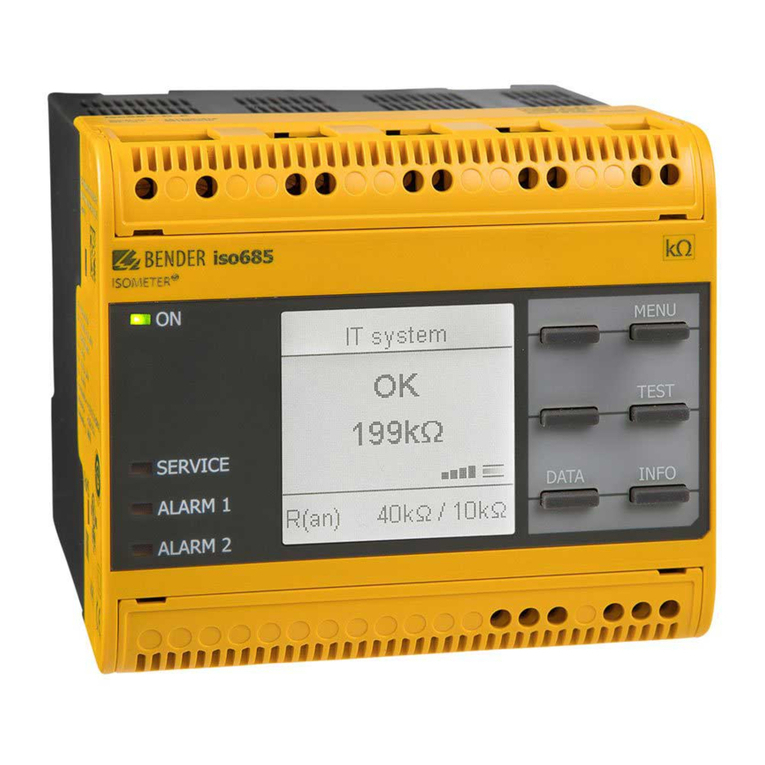
Bender
Bender ISOMETER isoRW685W-D manual
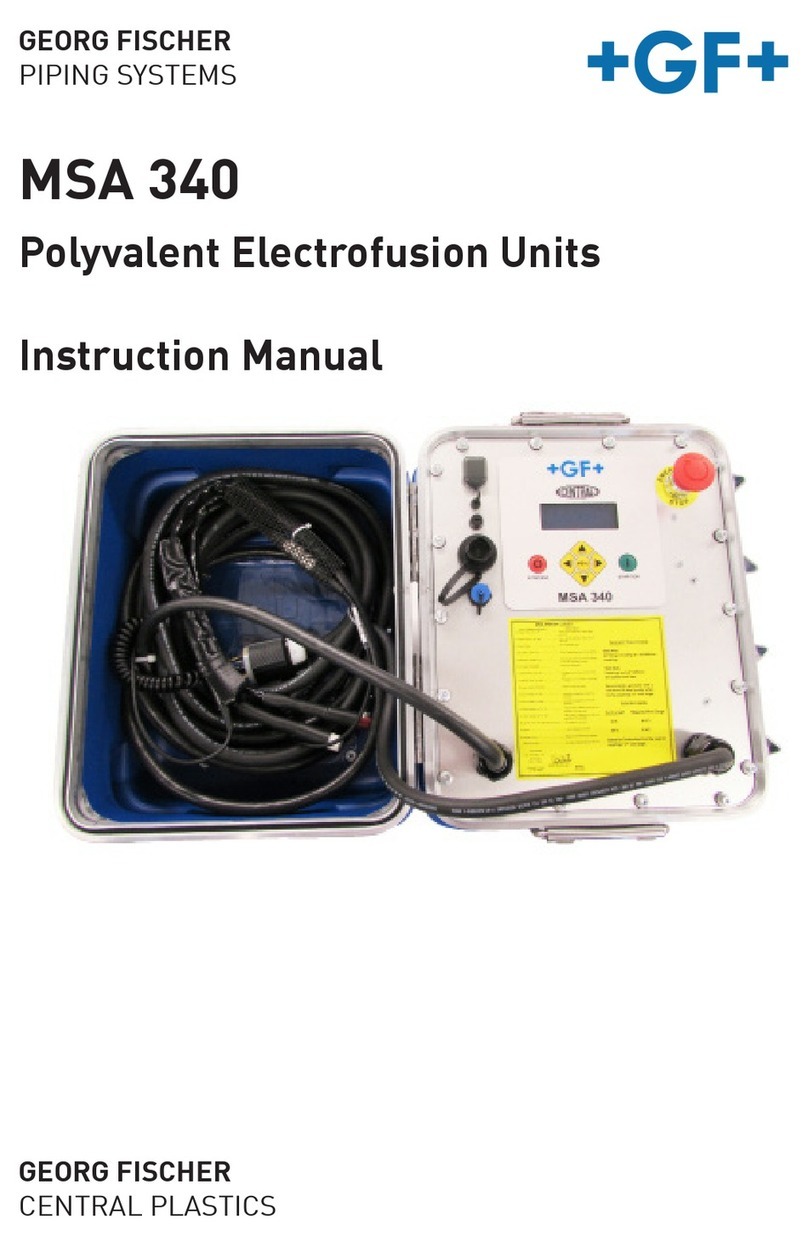
Georg Fischer Piping Systems
Georg Fischer Piping Systems MSA 340 instruction manual
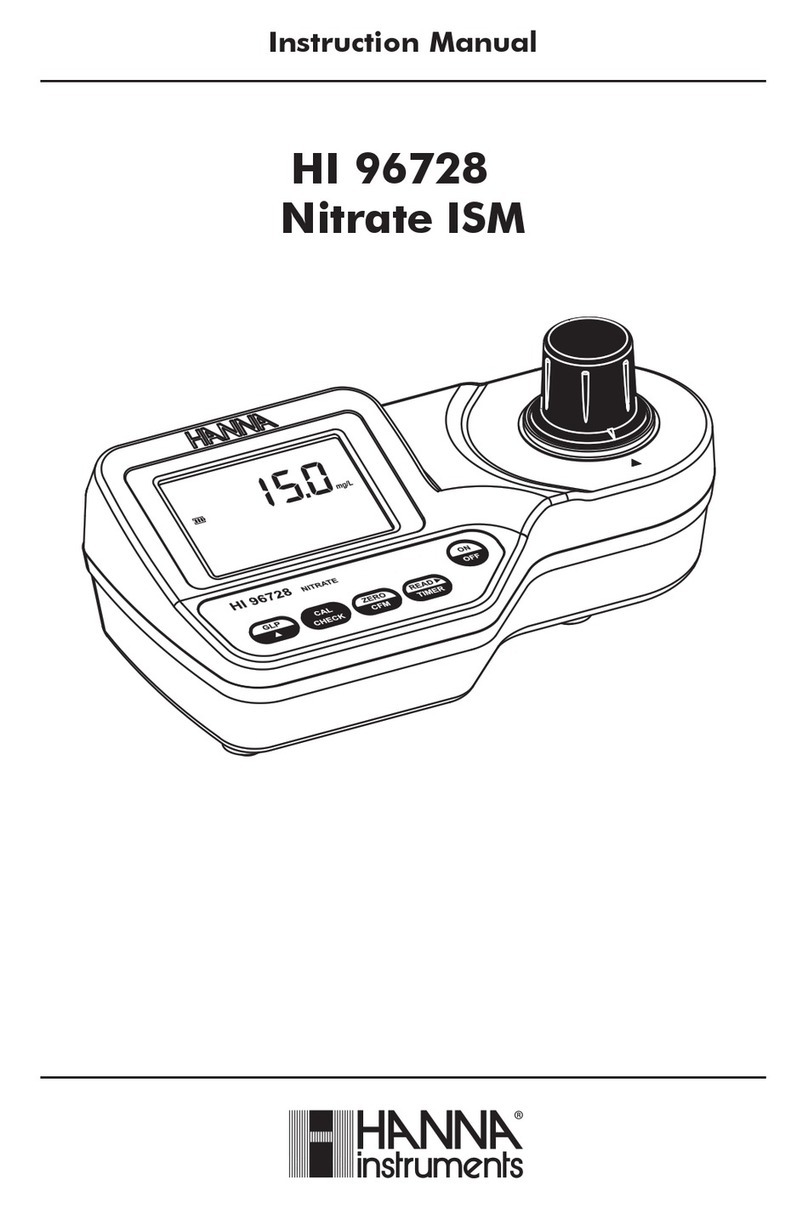
Hanna Instruments
Hanna Instruments 96728 instruction manual
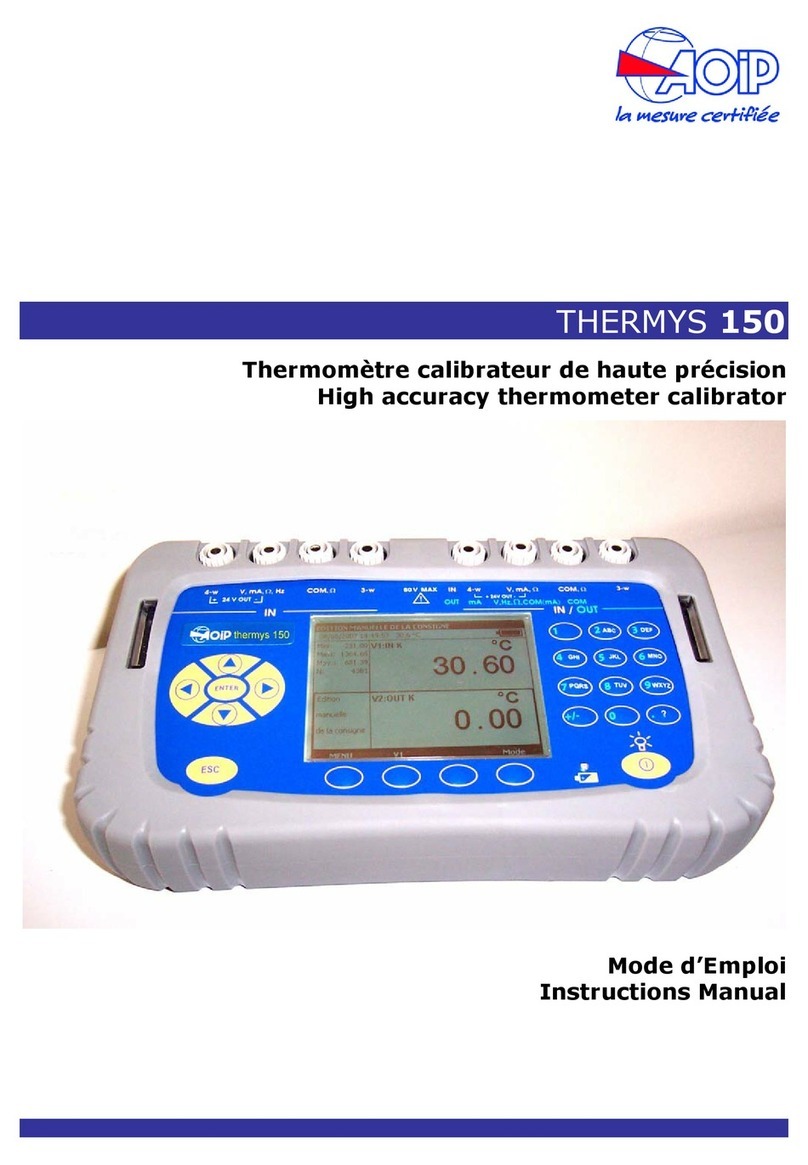
AOIP
AOIP THERMYS 150 instruction manual

Knick
Knick Stratos Pro A401B CONDI user manual

